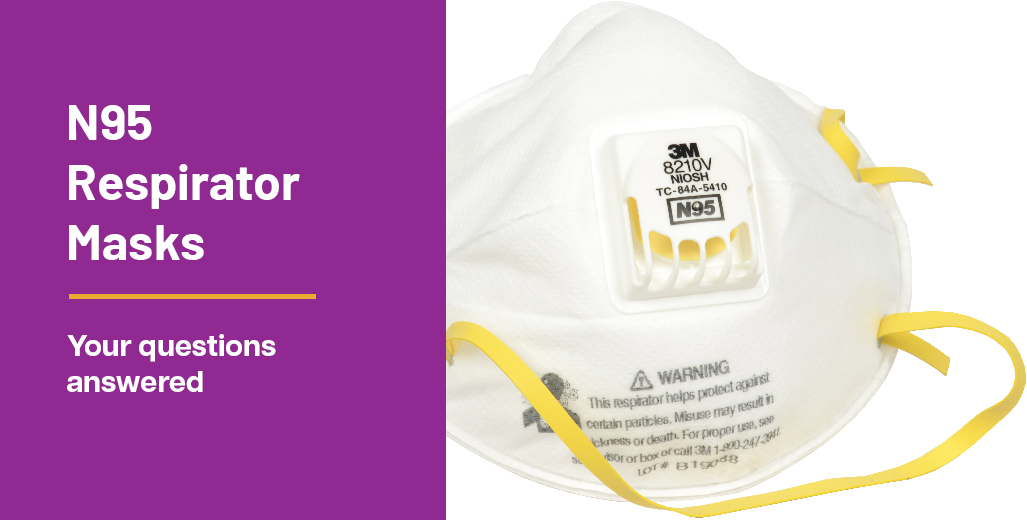
N95 Respirator Masks FAQs
The best way to avoid smoke inhalation is to stay inside. If it’s necessary to go outside in smoky conditions, here is some information on the use of N95 respirator masks.
Q. What is an N95 respirator?
A. An N95 respirator is an air-purifying respirator (APR) certified by the National Institute for Occupational Safety and Health (NIOSH). They are filter masks that fit over the nose and mouth, and when properly fitted, can filter 95% of smoke particles. However, N95 respirators do not filter toxic gases, vapors or the smell of smoke.
Q. Can an N95 respirator filter very small particles?
A. Yes, N95 respirators can filter particles less than 0.3 micrometers. By comparison, the width of a single human hair is approximately 60 micrometers.
Q. What does an N95 respirator protect against?
A. N95 respirators are designed to protect against particulate matter such as dust, fumes, mists, aerosols, and smoke particulates. It is also effective against biological particles such as pollen, mold spores, bacteria, viruses, animal dander and allergens. An N95 respirator is particularly effective against aerosolized droplets that are invisible to the naked eye.
Q.
What doesn’t an N95 respirator protect against?
A. N95 respirators are not effective against the smell of smoke or gases and vapors such as methane and carbon monoxide. Vapors may also include chemicals such as organic solvents and formaldehyde.
Q.
What are some limitations of the N95 respirator?
A. Some limitations of an N95 respirator include:
- They do not fit children and cannot be adapted to properly fit a child.
- Beards, stubble, or long mustaches may prevent an N95 from sealing to the face properly, causing leaks.
- It may be difficult for first-time users to put an N95 respirator on properly: practice putting it on before an emergency arises.
- If the wearer's face changes during the year (e.g., major weight loss or gain) another “fit test” should be performed.
Q: What is the difference between an N95 respirator and a dust or surgical mask?
A: N95 respirators are tested and certified by the National Institute for Occupational Safety and Health (NIOSH) to ensure they filter at least 95% of airborne particles.
Dust masks and surgical masks cannot offer a sufficient level of protection from particles during wildfire conditions or the cleanup process. Surgical masks are primarily designed to prevent biological particles from being expelled by the wearer into the environment.
Q: Will a wet towel or bandana provide any help?
A: A wet towel or bandana may stop large particles, but not the fine, small ones that can get into the lungs and cause respiratory problems.
Q: Will wearing an N95 respirator make it hard to breathe normally?
A: N95 respirators may make breathing more difficult and lead to increased breathing and heart rates. Individuals with heart and respiratory conditions should check with their doctor before wearing an N95 respirator.
Q. Are N95 respirators hard to put on?
A. No, but it’s important to make sure the mask is sealed against the face. To put it on, hold the respirator in the palm of your hand with the straps facing the floor. Place the N95 respirator on the face covering the nose and mouth. Pull the bottom strap up and over top of the head, to the back of the head and below the ears. Take the upper strap and pull it up so it rests on the crown of the head. Use your hands to snug the nose piece of the respirator to the bridge of the nose and around all edges for a tight seal. Check to ensure there is a good seal against the skin.
Q. How do I check the fit and seal of an N95 respirator?
A. There are several different makes and models of N95 respirators so it’s important to do a “fit test.” Always follow manufacturer’s instructions when putting on an N95.
It’s important that the respirator fits properly and air does not leak around the sides. If it does not fit properly, the respirator will provide little if any protection, and may offer a false sense of security.
Q. How long can an N95 respirator be worn?
N95 respirators should be worn for a maximum of eight hours and should be replaced regularly.
Q. Under what circumstances should I NOT wear an N95 respirator?
A. In the following situations, for the following reasons:
- N95 respirators do not provide oxygen so they should never be worn in a confined space with low oxygen levels.
- N95 respirators have no effect in an atmosphere containing toxic levels of gases or vapors.
- N95 respirators should not be used in certain industrial applications such as asbestos removal, sandblasting or painting.
Q. What about storing an N95 respirator?
A. Store N95 respirators in a clean environment to protect them from damage, contamination, dust, sunlight, extreme temperatures, and damaging chemicals. Proper storage will also prevent deformation of the respirator.
Q: What is the shelf life of an N95 respirator?
A: The standard shelf life of N95 respirators is a maximum of five years from production date and if it has been stored in the original packaging. Storage conditions can also affect shelf life.
Q.
What does the N in N95 stand for?
A. Particulate respirators and cartridges are classified by NIOSH into three classifications, N, R, and P.
- N class respirators/cartridges are not resistant to oil mists.
- R class respirators/cartridges are resistant to oil mists (<8 hours).
- P class respirators/cartridges are oil proof (>8 hours).
Q. What does the 95 in N95 stand for?
A. 95 refers to the efficiency of the filtration of the respirator or cartridge, meaning it filters at least 95% of 0.3 micrometers, meaning it has a 5% leakage factor.